Belize walkable routes and maps provide an essential framework for exploring this vibrant country on foot, ensuring you discover hidden gems and navigate with confidence. This guide offers practical insights and resources for planning your pedestrian adventures.
Planning a trip to Belize can feel a bit overwhelming, especially when it comes to getting around. Many travelers picture vast jungles and secluded beaches, but you might be surprised to learn that many of Belize’s most charming towns and even some adventure hubs offer fantastic opportunities for exploration on foot! However, finding reliable information on genuinely walkable routes and easily accessible maps for these areas can be a challenge. You don’t want to spend your precious vacation time lost or struggling with transportation. Don’t worry, fellow adventurer! We’re here to make it simple and stress-free. This guide will equip you with everything you need to confidently discover Belize’s beauty, one step at a time. Get ready to step out and explore!
Why Walking is a Great Way to See Belize
Belize might be known for its stunning barrier reef and ancient Maya ruins, but its heart beats in its towns and local communities. Walking allows you to connect with the culture on a more intimate level. You can weave through colorful streets, discover local eateries tucked away from the main tourist drag, and soak in the vibrant atmosphere at your own pace. Unlike relying solely on taxis or tours, walking lets you stumble upon unexpected delights and truly feel the pulse of a place. It’s also a fantastic way to stay active and enjoy the tropical climate.
Consider the benefits:
- Authentic Experiences: Interact with locals, try street food, and discover small shops you might otherwise miss.
- Cost-Effective: Save money on transportation by opting for walking whenever possible.
- Health & Wellness: Enjoy a bit of exercise while taking in the sights and sounds.
- Flexibility: Go where you want, when you want, without being tied to a tour schedule or taxi availability.
- Environmental Friendliness: Reduce your carbon footprint by choosing to walk.
Understanding Belize’s Walkability: Town by Town
While not every inch of Belize is designed for leisurely strolls, many popular destinations offer excellent walkability, especially within their central areas. The key is knowing which towns and districts are best suited for pedestrian exploration.
San Ignacio: The Hub for Adventure
San Ignacio, nestled in the Cayo District, is a bustling town and a gateway to many of Belize’s inland attractions. The town center itself is quite walkable, offering a taste of local life. You can easily explore the markets, shops, and restaurants along Burns Avenue and adjacent streets.
Walkable Areas in San Ignacio:
- Town Center: Burns Avenue and the streets branching off it are where most of the action is. You’ll find banks, shops, tour operators, and plenty of food stalls.
- Cayo Welcome Center: A good starting point to get information.
- San Ignacio Market: A vibrant place to experience local produce and goods.
- Hawkesworth Bridge: While you won’t walk across it for leisure, it’s a landmark in town.
Beyond the Town Center: For attractions like the Cahal Pech Maya Ruin, you’ll likely need a short taxi ride or a longer, more adventurous walk (approximately 30-45 minutes from town center). Xunantunich Maya Ruin is further afield and not walkable from San Ignacio. Always consider your fitness level and the tropical heat before embarking on longer walks outside the immediate town center.
San Pedro, Ambergris Caye: Island Vibes on Foot
San Pedro is Belize’s most popular island destination, and its main town on Ambergris Caye is surprisingly walkable, especially the central “downtown” area around the water taxi terminals. The island is mostly flat, making walking pleasant when temperatures allow.
Walkable Areas in San Pedro:
- Front Street (Barrier Reef Drive): This is the main artery, lined with shops, restaurants, bars, and hotels. It’s perfect for a leisurely stroll, especially in the cooler mornings and evenings.
- Back Street: Runs parallel to Front Street and offers a slightly more local feel.
- Waterfront Areas: Exploring along the docks where water taxis arrive and depart provides great views and access to many amenities.
Getting Around: While the main town is walkable, Ambergris Caye is large. For exploring further north or south along the island, golf carts are the primary mode of transportation, and bicycles are also a popular choice. Keep in mind that sandy roads can make walking more challenging in certain areas.
Caye Caulker: The Laid-Back Pace
Caye Caulker is famous for its motto, “Go Slow.” This laid-back island is nearly entirely walkable, making it a dream destination for pedestrians. There are no cars allowed on Caye Caulker, only golf carts and bicycles, so walking reigns supreme!
Walkable Areas on Caye Caulker:
- The Entire Main Village: From the north end to the south end, the island is small enough to traverse on foot.
- Front Street & The Path: These are the main routes, connecting everything you need.
- The “Split”: A popular swimming and sunbathing spot, easily reached by foot.
Tips for Caye Caulker: Even though it’s small, the heat can be intense. Stay hydrated, wear comfortable shoes, and embrace the slow pace. You’ll find everything you need within a pleasant walk.
Hopkins Village: Coastal Charm
Hopkins is a Garifuna village known for its beautiful beach and welcoming atmosphere. The village is spread out along the coast, but the main stretch and the areas leading to amenities are very walkable.
Walkable Areas in Hopkins:
- Beachfront: The entire length of the beach is a fantastic walking path.
- Village Path: A sandy path that runs parallel to the beach connects most guesthouses, restaurants, and shops.
- Main Road: While less scenic, it connects to shops and the main road leading further into the village.
Considerations: Hopkins is more spread out than Caye Caulker. While the core village is walkable, reaching certain resorts or the southern parts might be more comfortable via bicycle or a short taxi. The sandy terrain can be a bit more challenging than paved sidewalks.
Placencia Village: The Narrow Peninsula
Placencia is a charming village located on a narrow, 18-mile-long spit of land. The main village area is incredibly pedestrian-friendly and a joy to explore on foot.
Walkable Areas in Placencia:
- The Sidewalk: Placencia boasts the “World’s Narrowest Attached Sidewalk” (just 4 feet wide in places!), which runs for about 3 miles through the heart of the village. This is the ultimate pedestrian highway, lined with shops, restaurants, galleries, and colorful houses.
- Beach Access: Easy access to the Caribbean Sea on one side and the Placencia Lagoon on the other.
- Main Road: Runs parallel to the sidewalk and offers additional access points and amenities.
Beyond the Village: While the village itself is wonderfully walkable, the peninsula extends much further. For exploring the entire spit, bicycles and golf carts are popular. The northern end of the peninsula offers more secluded beaches and a quieter feel, best explored with your own wheels.
Essential Belize Walking Tools & Resources
Even in the most walkable areas, a few key items and resources will make your pedestrian adventures safer and more enjoyable. Preparation is key, especially in a tropical climate.
Essential Gear for Walking in Belize
- Comfortable Footwear: Sturdy walking shoes or sandals are a must. Consider water shoes if you plan on beach walks or wading.
- Lightweight, Breathable Clothing: Think linen, moisture-wicking fabrics.
- Sun Protection: A wide-brimmed hat, sunglasses, and high-SPF sunscreen are non-negotiable.
- Reusable Water Bottle: Staying hydrated is crucial. Look for places to refill it.
- Insect Repellent: Especially important for evenings or walks near jungle areas.
- Small Backpack or Day Bag: To carry your essentials.
- Portable Power Bank: To keep your phone charged for navigation and photos.
Belize Walking Map Resources
Finding detailed, free downloadable maps for specific walking routes can be tricky. However, here are the best ways to access maps and navigate:
1. Google Maps:
- Pros: Ubiquitous, generally accurate for roads and points of interest, allows offline map downloads. You can toggle satellite view to see terrain.
- Cons: May not show smaller pedestrian paths, can be less detailed on sandy or unpaved trails.
- How to Use: Download the map of your area for offline use before you leave your hotel Wi-Fi. Search for “walkable areas” or specific points of interest.
2. Maps.me:
- Pros: Highly detailed offline maps, often includes hiking trails and smaller footpaths that Google Maps misses. Open-source and community-driven.
- Cons: Requires downloading an app if you don’t have it, interface can be less intuitive for some users.
- How to Use: Download the Belize map before your trip. Use it to find points of interest and navigate using downloaded data.
3. Local Tourist Information Centers:
- Pros: Often have free physical maps or can point you to the best walking areas. Staff can give up-to-date advice on trail conditions or safe routes.
- Cons: Availability might be limited, maps can be basic.
- Where to Find: Look for tourist information booths in larger towns like San Ignacio, San Pedro, and Placencia.
4. Hotel/Guesthouse Staff:
- Pros: The best source for hyper-local, real-time advice. They know the best nearby walks, current conditions, and safety tips.
- Cons: Information is limited to what they know.
- How to Use: Always ask your accommodation staff for their recommendations on walkable routes.
5. Reputable Travel Websites & Blogs:
- Pros: Can highlight specific walkable routes or highlight towns known for walkability.
- Cons: Maps are rarely provided directly, often require cross-referencing with other map apps.
- Example: Look for articles focused on “walking in San Pedro” or “Caye Caulker guide.”
Planning Your Belize Walking Itinerary
To make the most of your walkable explorations, a little planning goes a long way. Here’s how to approach it:
- Identify Your Base: Choose accommodation in a town known for walkability if that’s a priority (e.g., Caye Caulker, Placencia Village, San Pedro town center).
- Set Realistic Daily Goals: Don’t plan to walk for 8 hours straight in the midday sun. Break up your explorations into morning and late afternoon/early evening strolls.
- Research Specific Routes: Once you know where you’re staying, do a quick search for “[Town Name] walking tour” or “things to do on foot in [Town Name].”
- Check the Weather: Belize can be hot and humid. Adjust your walking plans accordingly. Early mornings are often best.
- Factor in Hydration and Snacks: Plan stops at local shops or cafes to refuel.
- Safety First: Stick to well-lit areas, especially at night. Be aware of your surroundings. Inform someone of your walking route if you’re going off the beaten path.
Safety Tips for Walking in Belize
Belize is generally a safe country for tourists, but it’s always wise to take precautions, particularly when exploring on foot.
General Safety Advice
- Be Aware of Your Surroundings: Pay attention to what’s happening around you. Avoid walking alone late at night in unfamiliar or poorly lit areas.
- Keep Valuables Secure: Don’t flash expensive jewelry or electronics. Keep your wallet and phone discreet. Use a crossbody bag or fanny pack worn in front of you.
- Stay Hydrated: This cannot be stressed enough. The tropical heat can be dehydrating, leading to fatigue and heatstroke. Always carry water.
- Wear Appropriate Footwear: Comfortable, supportive shoes are essential to prevent blisters and injuries.
- Sun Protection: Reapply sunscreen regularly, wear a hat, and seek shade during the hottest parts of the day.
- Respect Local Customs: Dress modestly when away from beaches or resorts, especially when visiting villages or religious sites.
- Trust Your Gut: If a situation feels uncomfortable or unsafe, remove yourself from it.
- Learn a Few Local Phrases: “Hola” (hello) and “Gracias” (thank you) can go a long way in fostering positive interactions.
Specific Considerations for Walkability
- Road Conditions: While major roads are paved, many smaller streets, especially in villages, are unpaved and sandy. This can make walking more strenuous.
- Lack of Sidewalks: In some areas, you may find yourself walking alongside vehicle traffic. Be vigilant and position yourself safely.
- Wildlife: While rare in town centers, be aware of your surroundings if walking near jungle fringes, especially at dawn or dusk.
When Walking Isn’t Enough: Alternatives
Sometimes, walking just won’t cut it. Whether the distances are too great, the heat is overwhelming, or you need to reach more remote sites, Belize offers several reliable transportation alternatives.
Transportation Options
Here’s a quick look at your other transport choices:
| Transportation Method | Best For | Cost (General) | Notes |
|---|---|---|---|
| Taxis | Short to medium distances, getting to/from airports or bus stations, when walking is impractical. | Moderate | Agree on fare before starting trip. Most are not metered. Look for licensed taxis. |
| Bicycles | Exploring smaller towns (Caye Caulker, Placencia) or islands where distances are manageable. Good for covering more ground than walking but still getting exercise. | Low to moderate (rental) | Widely available for rent in tourist areas. |
| Golf Carts | Island hopping (Ambergris Caye, Caye Caulker) for a fun way to explore. | Moderate to High (rental) | Primary mode of transport on some islands. Rental required. |
| Local Busses | Traveling between towns. A very affordable and authentic way to see the country. | Very Low | Can be crowded, stops are frequent, and travel times are longer. Check schedules locally.
See the Belize Ministry of Transport for official advisories. |
| Water Taxis | Inter-island travel (e.g., Belize City to San Pedro/Caye Caulker) or coastal routes. | Moderate to High | Fast and efficient for accessing the cayes. |
| Rental Cars/Jeeps | Freedom to explore inland remote areas, national parks, and attractions at your own pace. | High | Requires a valid driver’s license. Roads can be challenging in some areas; 4WD may be advisable for certain regions. Check road conditions via expedia or local guides. |
When deciding, always weigh convenience, cost, and your desired level of immersion. For many, a combination of walking and short taxi rides or rentals offers the best of both worlds.
Discovering Belize’s Natural Beauty on Foot
While towns offer pedestrian-friendly experiences, Belize is also a land of natural wonders, and many of these are best explored via hiking trails. These are generally more demanding than town walks and require specific preparation.
Hiking in National Parks and Reserves
Belize is home to stunning national parks and wildlife reserves, each offering unique ecosystems and hiking opportunities.
- Cockscomb Basin Wildlife Sanctuary: Famous for its jaguar population, this sanctuary offers marked trails through dense rainforest. It’s a prime spot for birdwatching and experiencing jungle flora and




